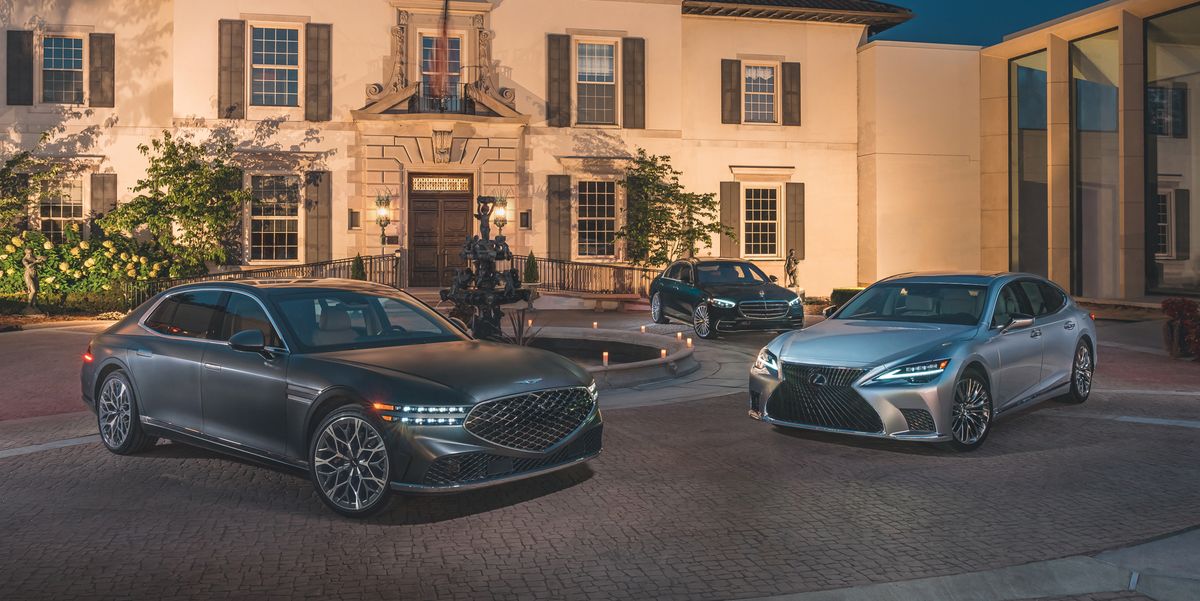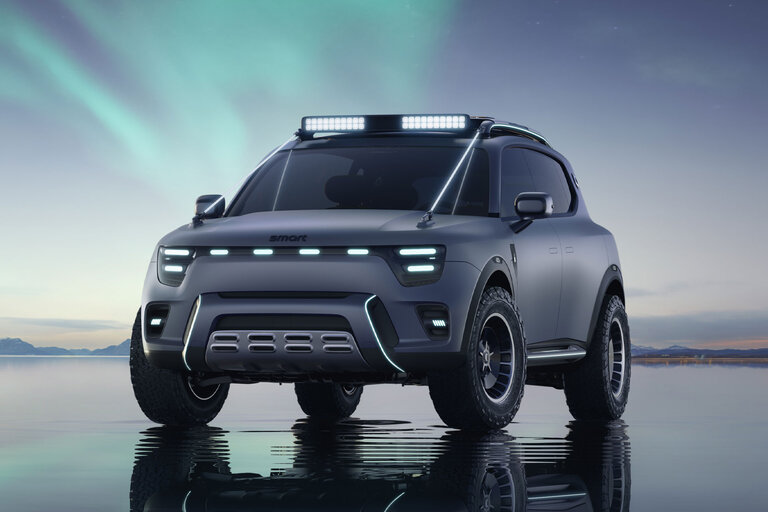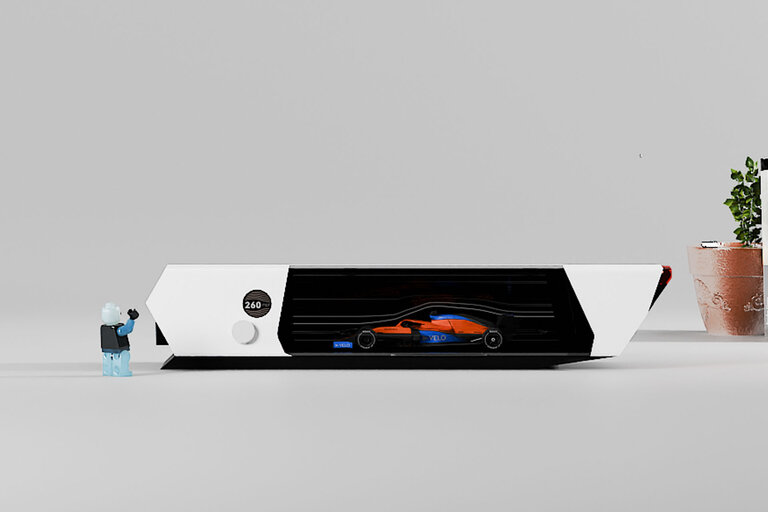
From the November 2022 issue of Car and Driver.
Wealth and power.
For decades, that’s what big luxury sedans have represented. They’ve been the flagships of upmarket brands, making journeys supremely comfortable while conferring a special status upon owners. Hotel parking-lot valets leave them out front. Movie and TV directors use them as props to signal prestige (think Succession). There are twice as many large luxury SUVs on the market today as large luxury sedans, but when a big, black, expensive sedan pulls up, it still gets attention. Several brands continue to build these cruise ships, so it seems like the right time to take the pulse of the luxe-sedan segment by pitting two important upscale nameplates against the standard-bearer.
The Mercedes-Benz S-class has long been the luxury car others are judged by. An S500 4Matic was the natural choice as this test’s benchmark. It’s the six-cylinder standard model—we’d never call it base—whose specifications best line up with our two challengers, the Lexus LS500 and the all-new Genesis G90, both also six-cylinder powered. Yes, there’s an S580 V-8 über-model, but it’s even more expensive, and the S500 already had the highest base price of our trio at $112,150.
As you would expect, the S500 comes well equipped for the cruise-ship mission with a 429-hp supercharged and turbocharged 3.0-liter inline-six with hybrid assist, all-wheel drive, air springs, adaptive dampers, every driver assist imaginable, and massaging front seats. Several interior options spruced up our test car. These included special Sienna brown-and-black nappa-leather upholstery ($2290), piano-black interior trim with embedded metal pinstripes ($1300), and multicolor ambient lighting ($790). Mechanical enhancements encompassed 21-inch AMG wheels shod in Pirelli P Zero PZ4 summer tires ($1750) and rear-wheel steering ($1300). An AMG Line package ($4300) dressed up the exterior with more aggressive front and rear fascias and side skirts. Our car was also equipped with the 3-D instrument cluster ($3000). The extras brought the sticker to $127,130—by far the priciest in the test.
At the other end of the price spectrum is the Lexus LS500 AWD, which starts at $80,500. Don’t be fooled by its fire-sale base price; while it includes luxury basics such as a 416-hp twin-turbo V-6 and all-wheel drive and has a reasonable list of amenities, it required almost $30,000 worth of options to match the equipment levels of the S500 and G90. Among the most expensive additions was the Executive package, with semi-aniline leather trim, massaging front seats, and power-reclining and massaging rear seats ($17,380). The LS also had air springs ($1400), a Mark Levinson audio setup ($1940), premium wood interior trim ($800), and the Lexus Safety System ($3200), which includes a bevy of additional driver assists. Options brought the as-tested price to $110,030.
By contrast, a Genesis G90 e-Supercharger AWD like our test car is the automotive equivalent of an all-inclusive resort vacation. The G90’s $99,795 base price accounts for virtually everything the S500 and the LS500 had—and in some cases more. The G90 has a 409-hp V-6, massaging front and rear seats, and a full selection of safety tech. Our mount arrived with but one option: Matte Gray paint ($1500).
Yes, the absence of a couple of other luxury cars is conspicuous. BMW didn’t yet have the just-introduced new 7-series stateside, and Audi couldn’t conjure up an A8, the current version of which is in its final model year. Nevertheless, the three vehicles we got gave us plenty to ponder.
What do you do with cruise ships? Do you really need to ask? We took them on a two-day, 500-mile lake-to-shining-lake luxe-life cruise. We started with a few laps on our favorite local back roads to assess their handling, then headed east to ritzy Grosse Pointe, located on Lake St. Clair, which separates Lake Huron from Lake Erie (and the United States from Canada). The area has been home to numerous auto-industry moguls since the early 20th century. We paused for sunset photos at a mansion that once belonged to Russell A. Alger Jr., an investor who helped found the Packard Motor Car Company. It’s now the Grosse Pointe War Memorial and a community center. From there we sailed west on interstates and two-lanes until we reached Lake Michigan and the picturesque resort town of South Haven. Upon arrival, we had our finish order of fabulousness.
3rd Place:
Lexus LS500
When Lexus introduced the original LS400 back in 1989, it was good enough to send shock waves through luxury carmakers’ engineering departments. Over time, its luster faded, and it now sells in small numbers. The current model won’t change that.
Highs: Plush front chairs, rich cabin materials, serene highway cruiser.
Lows: Clashing interior design themes, convoluted rear-seat controls, looks too much like a Toyota Avalon.
Verdict: The LS500 goes for radical in a conservative segment, and it doesn’t work.
The LS500 unfortunately lacks the visual gravitas that signals prestige. At first glance, it’s easy to mistake it for a commonplace Lexus ES—or a Toyota Avalon. In fact, someone on our test team mistakenly kept calling it “the Toyota.” Not a good sign.
Inside are expensive materials, plush seats, and a goodly number of worthwhile features. But the interior is unharmonious and busy bordering on jarring, with a mess of clashing design themes. The metal trim on the dash and doors looks designed for two different models. Many lesser cars have better-executed instrument clusters; the LS500’s lurks in a tight pocket sunk deep into the dash.
That’s too bad because the LS is otherwise pleasant. It rides softly and handles capably. Its twin-turbo V-6 engine hums quietly. Its 10-speed automatic behaves well. We enjoyed the cosseting softness of the driver’s seat and its comforting massage function. The audio system offers convenient knobs for volume and tuning. The massaging, reclining rear seats are a nice feature, but their touchscreen controls are so convoluted, they’re almost unusable. The awkward shifter, seemingly borrowed from a Toyota Prius, was annoying as well. In this expensive neighborhood, everything counts. The LS500 misses on too many big things.
2nd Place:
Genesis G90
This newly introduced second-gen G90 is a revelation. The Genesis has presence; it looks big and expensive but not derivative. The ambience inside is warm and inviting. The interior design is modern but appropriately restrained; the clunky steering wheel is the only off note. Electric motors open the doors and pull them closed with the push of a button. You know another car that does that? A Rolls-Royce Phantom. The infotainment system is straightforward and good-looking. It even offers a “mood curator” that combines massage, sounds, fragrance, and ambient lighting in four modes: Vitality, Delight, Care, and Comfort. We liked it.
Highs: Looks the part, beautiful interior, spectacular value.
Lows: Least comfy rear seats, clunky-chunky steering-wheel design.
Verdict: Presence that says you’ve arrived and rich appointments that make you feel like it too.
The G90 goes down the road like a cruise ship should—at 70 mph, it whispers along at 64 decibels inside the cabin, the quietest of the group. The suspension absorbs bad pavement with supple, well-damped movements, and the responses of the steering, brakes, and accelerator are progressive and refined. The 409-hp supercharged and twin-turbo 3.5-liter V-6 pulls well and is nearly silent around town. It emits a distant rasp only near the top of the rev band.
The G90’s one shortcoming is its reclining, massaging, heated, and ventilated rear seats. They need reshaping to be as comfy as the rear perch in the Benz. In the end, the Mercedes—with better performance, fuel economy, and driver engagement—outpointed the G90. But given its spectacular value and virtually equal luxuriousness, this Genesis earns our full-throated endorsement. In our hearts the result was a very close second—a moral victory if not an actual one.
1st Place:
Mercedes-Benz S500 4Matic
Mercedes has been building cars like this for a long time, and it shows. The S500 won because it gets the fundamentals right. That starts, unpredictably, with mass—the S500 weighs several hundred pounds less than either the G90 or the LS500. This S-class’s inline-six purrs like it’s made of money—it had the most silken engine note of the group—and zips the big sedan to 60 mph in just 4.6 seconds, the quickest in this test. The powertrain also delivers the best fuel economy. This was the only car of the three shod with summer tires, which helped give it the most cornering grip and shortest braking distance. In the Comfort drive mode, the Mercedes wafts along with a pillowy ride, but switch into Sport+, and it surprisingly behaves enough like a sports sedan to encourage your inner Lewis Hamilton.
Highs: Velvet-gloved powertrain refinement, opulent interior, wide ride-and-handling bandwidth.
Lows: Stingy on features for the price, that infotainment interface, steering-wheel controls require a surgeon’s hands.
Verdict: The class benchmark delivers the best-executed luxury-car fundamentals.
The S500 nails the luxury fundamentals too. Its paint is gorgeous. Its interior furnishings are opulent, its cabin detailing elegant. It has the most comfortable rear-passenger compartment thanks to immense legroom and perfectly shaped seat cushions. The tablet infotainment screen’s graphics are artful.
There are things about the S500 that should be better, though, considering the premium Mercedes charges for it. Our test car lacked not only reclining and massaging rear seats, but rear-seat HVAC controls, which both the Lexus and the Genesis offered. As we’ve said before, the company’s MBUX infotainment system is overly complicated, and the haptic steering-wheel controls that operate its functions are fussy. The instrument cluster’s 3-D feature left us asking “Why?”
Still, the S500 is great at the things you buy a luxury car for. It effortlessly eases down the road, encapsulating you in comfort. In all the ways that count, the S500 makes you feel rich. And isn’t that the point of the luxe life?
Specifications
Specifications
2023 Genesis G90 3.5T e-SC AWD
Vehicle Type: front-engine, all-wheel-drive, 5-passenger, 4-door sedan
PRICE
Base/As Tested: $99,795/$101,295
Options: Matte Gray paint, $1500
ENGINE
twin-turbocharged, supercharged, and intercooled DOHC 24-valve V-6, aluminum block and heads, direct and port fuel injection
Displacement: 212 in3, 3470 cm3
Power: 409 hp @ 5800 rpm
Torque: 405 lb-ft @ 1300 rpm
TRANSMISSION
8-speed automatic
CHASSIS
Suspension, F/R: multilink/multilink
Brakes, F/R: 14.2-in vented disc/14.2-in vented disc
Tires: Michelin Primacy Tour A/S
F: 245/40R-21 100V M+S GOE
R: 275/35R-21 103V M+S GOE
DIMENSIONS
Wheelbase: 125.2 in
Length: 207.7 in
Width: 76.0 in
Height: 58.7 in
Passenger Volume: 105 ft3
Trunk Volume: 11 ft3
Curb Weight: 5156 lb
C/D TEST RESULTS
60 mph: 5.1 sec
100 mph: 12.7 sec
1/4-Mile: 13.7 sec @ 104 mph
130 mph: 21.9 sec
Results above omit 1-ft rollout of 0.3 sec.
Rolling Start, 5–60 mph: 6.1 sec
Top Gear, 30–50 mph: 3.5 sec
Top Gear, 50–70 mph: 4.2 sec
Top Speed (gov ltd): 132 mph
Braking, 70–0 mph: 184 ft
Braking, 100–0 mph: 365 ft
Roadholding, 300-ft Skidpad: 0.84 g
C/D FUEL ECONOMY
Observed: 22 mpg
75-mph Highway Driving: 29 mpg
75-mph Highway Range: 550 mi
EPA FUEL ECONOMY
Combined/City/Highway: 20/17/24 mpg
—
2022 Lexus LS500 AWD
Vehicle Type: front-engine, all-wheel-drive, 5-passenger, 4-door sedan
PRICE
Base/As Tested: $80,500/$110,030
Options: Executive package (semi-aniline leather trim, massaging front seats, and power-reclining and massaging rear seats, suede headliner, four-zone climate control), $17,380; Lexus Safety System (pre-collision with pedestrian alert, intersection turning assist, front cross-traffic alert, lane-change assist, active cruise control, lane assist, road-sign assist, active high-beam headlamps, lane-departure alert), $3200; Mark Levinson stereo, $1940; adaptive air suspension, $1400; head-up display, $1200; 20-inch 10-spoke wheels, $880; premium wood interior trim, $800; illuminated door sills, $450; wood and leather heated steering wheel, $410; carpeted trunk mat, $120
ENGINE
twin-turbocharged and intercooled DOHC 24-valve V-6, aluminum block and heads, port and direct fuel injection
Displacement: 210 in3, 3445 cm3
Power: 416 hp @ 6000 rpm
Torque: 442 lb-ft @ 1600 rpm
TRANSMISSION
10-speed automatic
CHASSIS
Suspension, F/R: multilink/multilink
Brakes, F/R: 14.0-in vented disc/13.1-in vented disc
Tires: Bridgestone Turanza EL450 RFT
Size: 245/45R-20 99V M+S
DIMENSIONS
Wheelbase: 123.0 in
Length: 206.1 in
Width: 74.8 in
Height: 57.5 in
Passenger Volume: 99 ft3
Trunk Volume: 17 ft3
Curb Weight: 5129 lb
C/D TEST RESULTS
60 mph: 5.4 sec
100 mph: 12.8 sec
1/4-Mile: 13.7 sec @ 104 mph
130 mph: 22.3 sec
Results above omit 1-ft rollout of 0.3 sec.
Rolling Start, 5–60 mph: 6.2 sec
Top Gear, 30–50 mph: 3.4 sec
Top Gear, 50–70 mph: 4.1 sec
Top Speed (gov ltd): 140 mph
Braking, 70–0 mph: 185 ft
Braking, 100–0 mph: 371 ft
Roadholding, 300-ft Skidpad: 0.83 g
C/D FUEL ECONOMY
Observed: 22 mpg
75-mph Highway Driving: 29 mpg
75-mph Highway Range: 620 mi
EPA FUEL ECONOMY
Combined/City/Highway: 21/17/27 mpg
—
2022 Mercedes-Benz S500 4Matic
Vehicle Type: front-engine, all-wheel-drive, 5-passenger, 4-door sedan
PRICE
Base/As Tested: $112,150/$127,130
Options: AMG line (AMG wheels and sport front and rear bumpers and side skirts, stainless-steel sport pedals, AMG floor mats) $4300; 3-D technology package (augmented-reality head-up display, 3-D instrument cluster), $3000; Sienna brown-and-black nappa-leather interior trim, $2290; 21-inch AMG multispoke wheels with summer tires, $1750; piano-black interior trim with embedded metal pinstripes, $1300; rear-axle steering, $1300; active ambient lighting, $790; heated steering wheel, $250
ENGINE
turbocharged, supercharged, and intercooled DOHC 24-valve inline-6, aluminum block and head, direct fuel injection
Displacement: 183 in3, 2999 cm3
Power: 429 hp @ 6100 rpm
Torque: 384 lb-ft @ 1800 rpm
TRANSMISSION
9-speed automatic
CHASSIS
Suspension, F/R: multilink/multilink
Brakes, F/R: 14.5-in vented, cross-drilled disc/14.1-in vented, cross-drilled disc
Tires: Pirelli P Zero PZ4
F: 255/35R-21 95Y MO-S
R: 285/30R-21 100Y MO-S
DIMENSIONS
Wheelbase: 126.6 in
Length: 208.2 in
Width: 76.9 in
Height: 59.2 in
Passenger Volume: 120 ft3
Trunk Volume: 13 ft3
Curb Weight: 4786 lb
C/D TEST RESULTS
60 mph: 4.6 sec
100 mph: 11.5 sec
1/4-Mile: 13.1 sec @ 107 mph
Results above omit 1-ft rollout of 0.3 sec.
Rolling Start, 5–60 mph: 5.3 sec
Top Gear, 30–50 mph: 3.0 sec
Top Gear, 50–70 mph: 3.9 sec
Top Speed (gov ltd): 127 mph
Braking, 70–0 mph: 158 ft
Braking, 100–0 mph: 324 ft
Roadholding, 300-ft Skidpad: 0.91 g
C/D FUEL ECONOMY
Observed: 26 mpg
75-mph Highway Driving: 31 mpg
75-mph Highway Range: 680 mi
EPA FUEL ECONOMY
Combined/City/Highway: 24/21/30 mpg
This content is imported from OpenWeb. You may be able to find the same content in another format, or you may be able to find more information, at their web site.
#Genesis #G90 #Lexus #LS500 #MercedesBenz #S500
Source link






